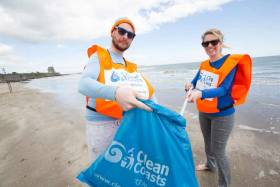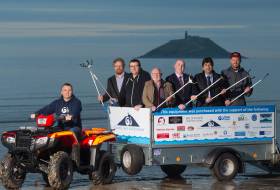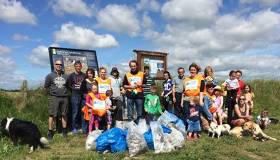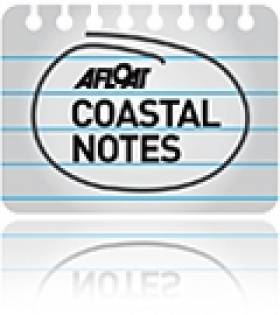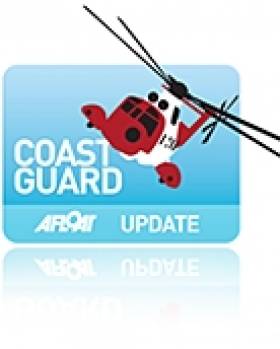Displaying items by tag: Beach
63 Tonnes of Marine Litter Removed in Ireland for the Big Beach Clean
Clean Coasts received overwhelming support and commitment from volunteers and communities across Ireland for the Big Beach Clean weekend that took place between 16th and 18th September.
This year, a record number of over 500 clean-ups were organised by volunteers who removed over 63 tonnes of litter nationwide.
Clean Coasts also joined forces with Irish business Cully and Sully, who supported the initiative again this year, and one of their registered group Clean Coasts Ballynamona, to host a flagship event at Ardnahinch, Co. Cork. Clean Coasts officers also attended beach cleans in several locations around Ireland.
The Big Beach Clean is an annual call to action that runs as part of the International Coastal Cleanup (ICC), operated internationally by Ocean Conservancy and invites communities and volunteers around the country to remove litter from around the Irish coast after the end of the bathing season.
 Big Beach Clean in Greystones, County Wicklow
Big Beach Clean in Greystones, County Wicklow
Once more, volunteers were asked to join the call to action, no matter how far from the coast. Statistics show that the number one cause of marine litter is litter dropped in towns and cities and getting involved in the Big Beach Clean has been a way for residents of non-coastal counties to help prevent litter entering our waterways tackle the problem at its source.
Each year this initiative is also an opportunity for Big Beach Clean volunteers to get involved in a worldwide citizen science project, which entails collecting the amount and types of litter on Irish beaches and filling in Clean Coasts’ Marine Litter Data Cards to share with Ocean Conservancy, help heighten awareness about the issue of marine litter serving as an indicator of the magnitude of the problem and help shape future policies and campaigns.
 Volunteers cleaning the beaches of Dungarvan
Volunteers cleaning the beaches of Dungarvan
So far, data collected from the International Coastal Cleanup have informed policy in a number of areas, leading to laws banning the use of plastic grocery bags; prohibiting smoking-related litter; encouraging the use of reusable bags; prohibiting mass balloon releases; and prohibiting foam food and beverage takeaway containers.
For the third year, Cully and Sully joined Clean Coasts as sponsors of this call-to-action. Cullen Allen (Cully) said, “We were delighted with yet another amazing Big Beach Clean weekend. The Clean Coasts staff and volunteers were fantastic across the weekend, although we know many are out every weekend of the year.. not just Big Beach Clean weekend.. so Thank You all. This is one of our favourite initiatives across the year and it was so heartwarming to see the great turn out yet again for 2022.”
Clean Coasts and Cully and Sully have also teamed up to create some resources to help people educate themselves on which household items are recyclable, which ones aren't and how to correctly dispose of rubbish in your home as well as rubbish found on the beach. If you’re curious about recycling basics, common beach finds and how to dispose of them, what happens to our waste, stats on recycling in Ireland and more, head to recycling webpage at: https://cleancoasts.org/how-to-recycle/
Clean Coasts’ Beach Clean 2018 Was Biggest Yet
Clean Coasts’ Big Beach Clean took place from 14th to 16th of September all over Ireland. Clean Coasts once again teamed up with the International Ocean Conservancy for the International Coastal Cleanup event.
This year the Big Beach Clean weekend in Ireland was the biggest yet, with
194 beach cleans took place around the coast of Ireland
Engaging 3,652 Clean Coasts volunteers
Removing over 32 tonnes of marine litter from our coastline
Each year millions of tonnes of marine litter enter our seas and oceans, resulting in environmental, economic, health and aesthetic challenges. Clean Coasts invited volunteers to join this global coastal clean-up helping remove marine litter from our beautiful coastline and in turn protecting our coastal habitats and marine life.
During the Big Beach Clean, Clean Coasts volunteers were asked to carry out marine litter surveys to quantify the amount and types of litter on Irish beaches. These surveys are aimed at heightening awareness about the issue of marine litter and serve as an indicator of the magnitude of the problem.
Speaking about the Big Beach Clean, Sinead McCoy, Clean Coasts National Manager
said, “We are so lucky in Ireland to have such spectacular sandy beaches and rocky shores but each year millions of tonnes of litter enter our seas and oceans causing environmental, economic, health and aesthetic challenges. We all have a responsibility in caring for our coastline so the Clean Coasts programme is incredibly proud of the amazing volunteer effort that joined this call to action over the past weekend, helping to remove marine litter from our beautiful coastline and aid in the protection of our coastal habitats and marine life”.
East Cork Community Protects Its Beaches
Ballynamona Strand on the East Cork coastline is internationally renowned for a long list of bird life including Shrikes, Larks, Citrine Wagtails, Sandpipers, Pipits, American Coot and Red-necked Stint. There is a new sight to be seen there, writes Tom MacSweeney and it is ensuring that the strand remains a welcoming place for wildlife, seabirds, marine life and for the general public. Regrettably, visitors of the human kind leave litter behind, disregarding the marine environment and despoiling the area.
The local community has responded leading to the new sight on the beach - a quad bike and trailer - showing community dedication to the preservation of a clean maritime environment. It’s the work of the group known as ‘Clean Coasts Ballynamona.’ “Truly an excellent example of what can be achieved when business and community work together,” said Proinsias Ó Tuama, one of the leaders of ‘Clean Coasts’ ‘and a teacher at St.Colman’s Community College, Midleton, where students are also involved in the protection of local beaches. Business and community interests raised €16,000 for a quad bike and trailer to remove beach litter. “It shows how local people are concerned for their maritime environment.”
The Ballynamona group has twice been An Taisce ‘Ocean Hero’ national award winners and has been using the equipment to maintain over 30kms. of coastline by removing marine litter from Ballybranagan to Ballymacoda in East Cork. Five tonnes of rubbish was taken from Ballybranagan beach with the help of the Transition Year students.
East Cork Coast Cleaning at Ballynamona This Weekend
‘Clean Coasts Ballynamona’ will take their coast cleaning project to Ballynamona Beach near Shanagarry in East Cork this weekend.
On Sunday morning next, August 14, at 10 am. they will carry out a beach clean at Ballynamona.
‘Clean Coasts Ballynamona’ are An Taisce Ocean Hero winners for 2015/16 in the Best Newcomer section.
Proinsias Ó Tuama of the group says: “ It will last one hour. We will also be holding a Sandcastle competition as part of our morning’s activities for all the kids – both big and small. Prizes will be awarded for the best sandcastles. All are welcome.
“Our work continues for cleaner, safer beaches by the community in the East Cork Area.”
Clean Coasts’ Big Beach Clean Takes Place This Weekend
Clean Coasts’ Big Beach Clean is taking place this weekend 18th-20th of September all along the Irish coastline. Clean Coasts is teaming up with the International Ocean Conservancy once again for the International Coastal Cleanup event. Last year 560,000 volunteer in 91 countries removed 7,257 tonnes of marine litter from the world's oceans. This year thousands of volunteers will be participating in beach cleans nationwide and you can search for a clean up near you on our website www.cleancoast.org
Michael John O Mahony Director of An Taisce’s Environmental Education Unit said, “Each year millions of tonnes of litter enter our seas and oceans, resulting in environmental, economic, health and aesthetic challenges. The Clean Coasts programme is inviting volunteers to join this global coastal clean-up helping remove marine litter from our beautiful coastline and aid in the protection of our coastal habitats and marine life”.
During the Big Beach Clean, Clean Coasts’ volunteers are asked to carry out marine litter surveys to quantify the amount and types of litter on Irish beaches. These surveys are aimed at heightening awareness about the issue of marine litter and serve as an indicator of the magnitude of the problem.
'Excellent' Result for Clare Bathing Areas in EPA report
#clarebeaches – A newly published report by the EPA on Bathing Water Quality around Ireland has found that County Clare's 11 designated bathing areas were adjudged to have "Excellent Water Quality" during 2014.
The marine environment news has been described as "hugely significant and positive news" by Clare County Council in light of the newly introduced EU standards for bathing areas, deemed by the EPA to be almost twice as strict as those applied in previous years.
Bathing waters were classified into four categories, namely 'Poor', 'Sufficient', 'Good' and the newly introduced 'Excellent' category. The classification system is based on the levels of E. Coli and intestinal enterococci detected in the bathing water during the 2014 bathing season.
Clare is one of five Local Authority areas to receive "Excellent" classifications for each of its bathing areas, the others being Dun Laoghaire Rathdown, Kerry, Leitrim and Louth.
Clare's 11 bathing areas are Ballyalla Lake (Ennis), White Strand (Milltown Malbay), Ballycuggeran (Lough Derg), Cappa Pier (Kilrush), Bishopsquarter, White Strand (Doonbeg), Kilkee, Spanish Point, Lahinch, Fanore and Mountshannon (Lough Derg).
"This is a magnificent achievement for County Clare and those who work throughout the year to safeguard our bathing areas from environmental pollution and to ensure that the public can enjoy these locations in the knowledge that they are bathing in clean waters," stated Councillor John Crowe, Cathaoirleach of Clare County Council.
He added: "This clean sweep for Clare is something that all tourism interests in the County should be aware of as we must now promote our quality beaches and other bathing locations, particularly in light of the growing numbers of visitors arriving in Clare during their journey along the Wild Atlantic Way."
"I wish to pay tribute to the Environment Section of Clare County Council and those living and working in the vicinity of Clare's 11 bathing locations for their due diligence and hard work in delivering this result. It's one that benefits our County's reputation and of course, the environment," said Councillor Crowe.
"The Council is delighted that each of the 11 designated bathing areas that it monitors achieved 'Excellent' status. This achievement is notable in light of the considerable disruption caused to many locations during the storms of early 2014, as well as the newly introduced standards for assessing bathing areas which are almost twice as strict as those previously applied. Our goal now is to maintain these high standards throughout 2015," explained Paul Moroney Senior Engineer, Clare County Council:
Commenting on the bathing water quality results, Dr Matthew Crowe, Director of the EPA's Office of Environmental Assessment, said: "Overall, the quality of Ireland's bathing waters continues to be very good and new standards introduced in 2014 provide a much higher level of protection for bathers."
"Disappointingly, seven identified bathing waters have been assessed as being of poor quality. The relevant local authorities and Irish Water have put management plans in place to tackle the main pollution risks at these beaches. The test will be whether or not we see the necessary improvements in water quality at these beaches," added Dr. Crowe.
The summary report 'Bathing Water Quality in Ireland – A Report for the Year 2014' is available to download from www.epa.ie.
#Rescue - Castlerock RNLI lifeguards rescued a family of six after they got into difficulty on the town’s seaside beach in Co Derry yesterday (7 July).
Senior RNLI lifeguard Gordon Clark was patrolling busy Castlerock beach when at he noticed a person in the water waving for help a short distance to the right of the flagged zone on the beach around 5.30pm.
The family of six – including a man, woman and four children – were all on bodyboards when they got caught in what appeared to be a flash rip, a strong current running out to sea.
After radioing for assistance, Clark swiftly entered the sea with a rescue tube. He was quickly joined in the rescue operation by his RNLI lifeguard colleagues Jenny Thompson and Ray Cunningham.
Clark and Thompson proceeded to safely ferry the children, followed by their parents, to the shore, where they were checked over to ensure they hadn’t taken on any water. All were safe and well.
Speaking following the rescue, Mike Grocott, RNLI lifeguard manager for Northern Ireland, said: "Rip currents often catch people out because they can be difficult to spot, and research shows that most people don’t know how to identify one. They are a major cause of incidents that the RNLI’s lifeguards deal with each season.
"Anyone who gets caught in a rip should try to remain calm, raise their arm in the air to signal for help like the family member did today. If they feel they can swim, they should swim parallel to the beach until free of the current, and then head for shore."
With temperatures expected to soar this week, Grocott reminded people to be mindful of the RNLI’s key safety recommendations – choose a lifeguarded beach and swim between the red and yellow flags, which mark the safest area to swim and are an indicator that lifeguards are on duty.
#beach – Clare County Council, on the advice of the Health Service Executive (HSE), has today (Saturday, 21 July 2012) lifted restrictions relating to public bathing at Lahinch, Kilkee and Spanish Point beaches.
The Council confirmed that the preliminary results of water samples taken from the three bathing areas yesterday (Friday) have shown a dramatic reduction of levels of bacteria in the water. The Council and HSE said an improvement in weather conditions in recent days has been the main contributory factor to the positive results.
As previously reported on Afloat.ie the prohibition on bathing at the three locations was put in place on Friday after the results of routine tests on water samples at the three beaches showed up elevated levels of bacteria.
According to Anne Haugh, Director of Services, Clare County Council: "On the advice of the HSE and following analysis of water samples, the Council is delighted to be able to announce the lifting of all restrictions relating to bathing at Lahinch, Kilkee and Spanish Point. Public notices indicating that swimming and surfing at the three locations are no longer prohibited are being erected this afternoon, while the Blue Flag at Lahinch and Kilkee beaches have been restored having been temporarily withdrawn on Friday. Lifeguards at each of the three bathing areas also have been instructed to remove all red flags which had indicated that bathing was prohibited."
Liam Griffin, Water Safety Officer, Clare County Council added: "Clare County Council would like to thank the public for their understanding and cooperation over the past 24 hours. The local authority also acknowledges the valuable role played by the media in promoting the public health notices."
Coastguard Warns of Seaside Danger to Children
#coastguard – Now that the school holidays are here, Coastguards in Scotland and Northern Ireland have issued a timely notice to encourage children and families to stay safe whilst at the beach and along the coast.
Phil MacIver, HM Coastguard Sector Manager at Buchan said:
"We'd like to warn people against jumping into the water from cliffs and structures such as piers and bridges. Every year, nationally we deal with several serious injuries and some deaths as a result of this kind of activity. Tides make a massive difference and what may have been a deep lagoon could be just a shallow puddle only a couple of hours later. At this time of the year the water is still cold so be careful when entering the water, do it slowly and acclimatise gradually.
"Coastguards have also noticed an increase in the number of dogs that have fallen down cliffs. We'd like to warn people against attempting to rescue their dogs and encourage them to call the coastguard and ask for assistance.
"We want everyone who visits our coast to have a great time and to go home with happy memories. If you choose a lifeguarded beach and swim between the red and yellow flags you'll ensure that you have expert lifesavers looking out for you while you're in the water. The Royal National Lifeboat Institution (RNLI) has launched a new 'beach finder' mobile app to make it easy for anyone heading to the seaside this summer to find their nearest lifeguarded beach, helping them to have fun whilst enjoying a safe visit. The app is available to download free-of-charge on both Android and Apple devices from www.rnli.org/beach
"If you're looking after children make sure that they are well supervised by adults whilst at the coast. We deal with numerous cases of lost children every year and it can be very distressing for children and adults alike.
"If you notice that someone is in difficulty, either alert the lifeguard if one is available or call the coastguard on 999.
Finally, have a great time and return home safely."
More information here
This Friday Last Day for 2012 Fingal Lifeguard Applicants
#WATER SAFETY - This coming Friday 30 March is the closing date for applications for Fingal County Council beach lifeguards for the 2012 summer season.
Lifeguard cover will be provided on Fingal beaches on weekdays and weekends 11am to 7pm from 2 July till the last week of August, depending on weather and staff levels.
Beaches and bathing places scheduled to be guarded this summer include Balbriggan (front beach), Skerries South, Loughskinny, Rush North and South Shores, Portrane (Tower Bay and The Brook), Donabate, Malahide, Portmarnock, Sutton (Burrow Road) and Howth (Claremount).
Applicants must be not less than 17 years of age on 1 May 2012. Application forms are available to download HERE.



























